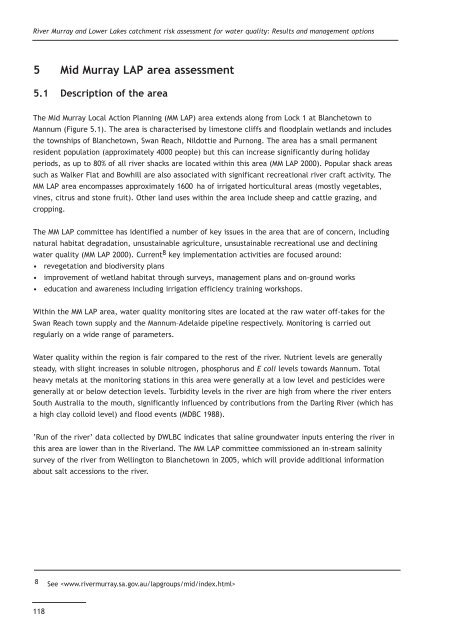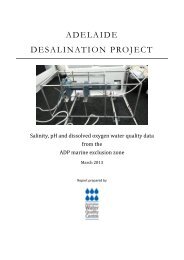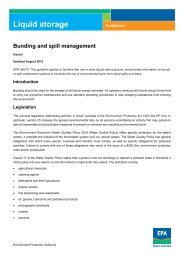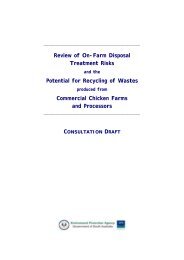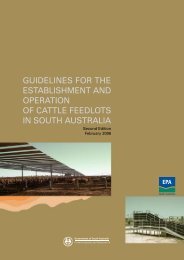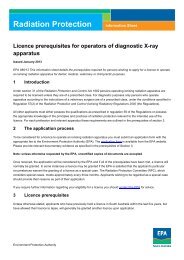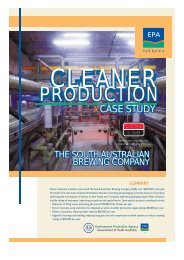2 Renmark to border LAP area assessment - EPA - Sa.gov.au
2 Renmark to border LAP area assessment - EPA - Sa.gov.au
2 Renmark to border LAP area assessment - EPA - Sa.gov.au
Create successful ePaper yourself
Turn your PDF publications into a flip-book with our unique Google optimized e-Paper software.
River Murray and Lower Lakes catchment risk <strong>assessment</strong> for water quality: Results and management options<br />
5 Mid Murray <strong>LAP</strong> <strong>area</strong> <strong>assessment</strong><br />
5.1 Description of the <strong>area</strong><br />
The Mid Murray Local Action Planning (MM <strong>LAP</strong>) <strong>area</strong> extends along from Lock 1 at Blanche<strong>to</strong>wn <strong>to</strong><br />
Mannum (Figure 5.1). The <strong>area</strong> is characterised by limes<strong>to</strong>ne cliffs and floodplain wetlands and includes<br />
the <strong>to</strong>wnships of Blanche<strong>to</strong>wn, Swan Reach, Nildottie and Purnong. The <strong>area</strong> has a small permanent<br />
resident population (approximately 4000 people) but this can increase significantly during holiday<br />
periods, as up <strong>to</strong> 80% of all river shacks are located within this <strong>area</strong> (MM <strong>LAP</strong> 2000). Popular shack <strong>area</strong>s<br />
such as Walker Flat and Bowhill are also associated with significant recreational river craft activity. The<br />
MM <strong>LAP</strong> <strong>area</strong> encompasses approximately 1600 ha of irrigated horticultural <strong>area</strong>s (mostly vegetables,<br />
vines, citrus and s<strong>to</strong>ne fruit). Other land uses within the <strong>area</strong> include sheep and cattle grazing, and<br />
cropping.<br />
The MM <strong>LAP</strong> committee has identified a number of key issues in the <strong>area</strong> that are of concern, including<br />
natural habitat degradation, unsustainable agriculture, unsustainable recreational use and declining<br />
water quality (MM <strong>LAP</strong> 2000). Current8 key implementation activities are focused around:<br />
• revegetation and biodiversity plans<br />
• improvement of wetland habitat through surveys, management plans and on-ground works<br />
• education and awareness including irrigation efficiency training workshops.<br />
Within the MM <strong>LAP</strong> <strong>area</strong>, water quality moni<strong>to</strong>ring sites are located at the raw water off-takes for the<br />
Swan Reach <strong>to</strong>wn supply and the Mannum–Adelaide pipeline respectively. Moni<strong>to</strong>ring is carried out<br />
regularly on a wide range of parameters.<br />
Water quality within the region is fair compared <strong>to</strong> the rest of the river. Nutrient levels are generally<br />
steady, with slight increases in soluble nitrogen, phosphorus and E coli levels <strong>to</strong>wards Mannum. Total<br />
heavy metals at the moni<strong>to</strong>ring stations in this <strong>area</strong> were generally at a low level and pesticides were<br />
generally at or below detection levels. Turbidity levels in the river are high from where the river enters<br />
South Australia <strong>to</strong> the mouth, significantly influenced by contributions from the Darling River (which has<br />
a high clay colloid level) and flood events (MDBC 1988).<br />
‘Run of the river’ data collected by DWLBC indicates that saline groundwater inputs entering the river in<br />
this <strong>area</strong> are lower than in the Riverland. The MM <strong>LAP</strong> committee commissioned an in-stream salinity<br />
survey of the river from Welling<strong>to</strong>n <strong>to</strong> Blanche<strong>to</strong>wn in 2005, which will provide additional information<br />
about salt accessions <strong>to</strong> the river.<br />
8 See <br />
118


